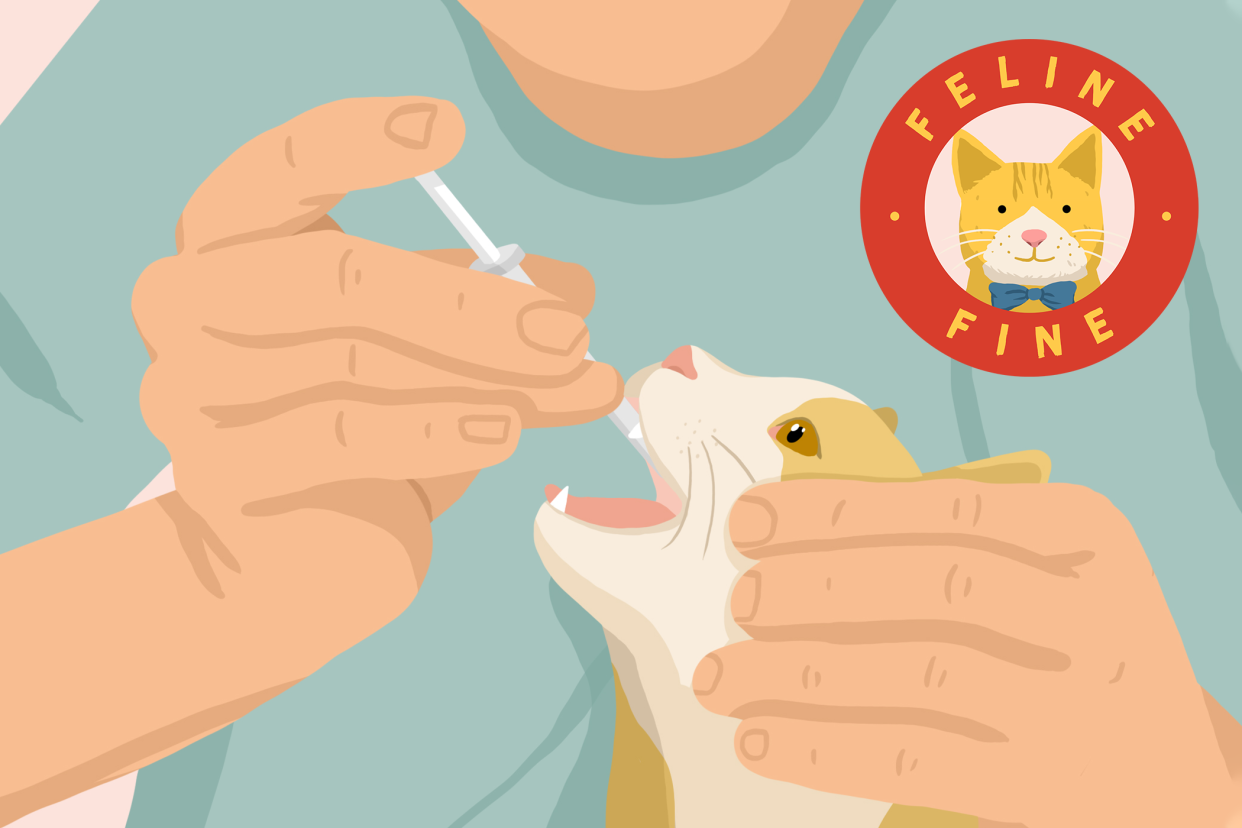How to Give a Cat Liquid Medicine

Yeji Kim
If you're wondering how to give a cat liquid medicine, you're certainly not alone. The idea of depressing a medicine-filled syringe into your cat's mouth probably isn't a welcome sight on anyone's to-do lists.
There are ways to make it easier, however, including some that let you avoid the syringe altogether. But if you have to use the syringe, preparation and flavoring agents can make the process a little tastier for your cat.
"You're kind of programming them to have a positive experience," Randy Wheeler, DVM and executive director of the Iowa Veterinary Medical Association, tells Daily Paws.
RELATED: How Often to Take Your Kitten or Cat to the Vet
How to Give Your Cat Liquid Medicine in a Syringe
There are several reasons your cat could be prescribed liquid medicine, says Lauren Demos, BVMS, MRCVS, and a former president of the American Association of Feline Practitioners. Pain relievers and antibiotics come in liquid form, as do medications for thyroid issues, liver problems, and heart disease.
When your cat is prescribed liquid medicine, ask your veterinarian about flavoring agents. Those can make the medicine taste like fish or chicken, which is a lot better than just the medicine, Wheeler says. In fact, he recommends getting your cat used to the syringe by just giving him doses of the flavoring agent without the meds. Then it might not be so bad when the actual medicine comes along.
Every cat is different, but here are some general tips on safely giving your cat liquid medicine through a syringe. As always, talk with your vet about any tips they have because they know you and your cat best. They might even show you how to do it.
1. Early Preparation
Add the prescribed amount of medicine and any flavoring to the syringe. Locate your cat and make sure he can't escape easily into another room or part of the house. "I often skip the morning breakfast, do medications, then feed a patient, so there's also a reward at the end," Demos says.
2. Ready Your Cat
Position your feline on a surface where they're comfortable and won't slide around, Wheeler says. That might mean putting a towel down or even wrapping them in it. You might even employ a "cat bag," almost a sleeping bag for cats, to keep him secure. You'll want to do your best to make sure your cat is in a comfortable, familiar setting, another reason you might want to practice with only the flavoring agent first.
Every cat is different, but some will try to escape—something you definitely don't want to happen when a syringe is near or in a cat's mouth.
"We don't want them jumping off and hurting themselves," Wheeler says.
3. Using the Syringe
Time to do the deed. For this, Canadian veterinarian Uri Burstyn has an excellent how-to video you can watch below. The basics: face your cat away from you; hold your cat's head with your non-dominant hand; and grab the syringe with your dominant hand. Then, follow these steps:
Sweep the whiskers back and tilt the cat's head up;
Work the syringe in through the side of the mouth;
Inject the medicine;
Stroke under the cat's chin to make sure he swallows
The process might not go smoothly your first few tries, but it will hopefully get easier and quicker the more you and your cat practice.
RELATED: What to Do if You Think Your Cat's Been Poisoned
How to Hide a Cat's Liquid Medicine in Wet Food
There is a primary alternative to a syringe, and that's putting the medicine on top of some wet cat food. That can work for small doses, especially if they're flavored, Demos says. She'll prepare a small amount of food and then add the medicine on top of it. Yum!
The potential downside is your cat might not consume all the medicine in the dish, which might be why you have to opt for the syringe method.
Tips for Giving Medicine to Cats Who Won't Take Liquid Medicine From a Syringe
Demos has one simple tip: See if there's another vehicle for your cat's meds, whether it's a pill (maybe you can use a pill pocket), injection, or a transdermal method, meaning the medicine is applied to your cat's skin. Your cat might tolerate one of those methods more than a syringe.
As always, talk with your vet. They know you and your cat best and can figure out the best way to make sure he gets the medicine he needs.

